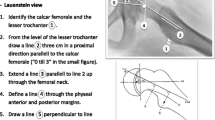Abstract
Background
The characteristics of patients who sustain unstable slipped capital femoral epiphyses (SCFEs) are not well described compared to their counterparts who sustain stable SCFE. Although patients with unstable slips are usually identified owing to acute symptoms, it is unclear whether these patients have premonitory symptoms that could heighten the awareness of treating physicians to the possibility of an unstable slip and lead to timely diagnosis and treatment.
Questions/purpose
We determined whether most patients experienced pain and limp before developing an unstable SCFE.
Methods
We retrospectively reviewed 582 patients and identified 82 (41 boys, 41 girls; 85 hips) with unstable SCFEs. Patient records were reviewed for sex, age at onset, weight at onset, and presence and location of pain and/or limp before the unstable slip. Boys averaged 13 years of age at the time occurrence and weighed on average in the 77th percentile. Girls averaged 12 years of age at the time of occurrence and weighed on average in the 79th percentile.
Results
For all patients, 73 of 82 (88%) had pain in their hips, thighs, or knees for an average of 42 days before sustaining unstable SCFEs. Sex distribution was equal for patients with unstable SCFEs.
Conclusions
Patients who sustained unstable SCFEs had premonitory pain in the limb. Early recognition and an appropriate diagnosis provide a critical opportunity to prevent a morbid unstable SCFE.
Level of Evidence
Level IV, diagnostic study, See Instructions for Authors for a complete description of levels of evidence.


Similar content being viewed by others
References
Bhatia NN, Pirpiris M, Otsuka NY. Body mass index in patients with slipped capital femoral epiphysis. J Pediatr Orthop. 2006;26:197–199.
Castro FP Jr, Bennett JT, Doulens K. Epidemiological perspective on prophylactic pinning in patients with unilateral slipped capital femoral epiphysis. J Pediatr Orthop. 2000;20:745–748.
Fahey JJ, O’Brien ET. Acute slipped capital femoral epiphysis: review of the literature and report of ten cases. J Bone Joint Surg Am. 1965;47:1105–1127.
Gordon JE, Abrahams MS, Dobbs MB, Luhmann SJ, Schoenecker PL. Early reduction, arthrotomy, and cannulated screw fixation in unstable slipped capital femoral epiphysis treatment. J Pediatr Orthop. 2002;22:352–358.
Herrera-Soto JA, Vanderhave KL, Gordon E, Fabregas J, Phillips JH, Schoenecker P, Parsch K. Bilateral unstable slipped capital femoral epiphysis: a look at risk factors. Orthopedics. 2011;34:e121–e126.
Kalogrianitis S, Tan CK, Kemp GJ, Bass A, Bruce C. Does unstable slipped capital femoral epiphysis require urgent stabilization? J Pediatr Orthop B. 2007;16:6–9.
Kennedy JG, Hresko MT, Kasser JR, Shrock KB, Zurakowski D, Waters PM, Millis MB. Osteonecrosis of the femoral head associated with slipped capital femoral epiphysis. J Pediatr Orthop. 2001;21:189–193.
Kuczmarski RJ, Ogden CL, Grummer LM, Flegal KM, Guo SS, Wei R, Mei Z, Curtin LR, Roche AF, Johnson C. CDC Growth Charts: United States Developed by the National Center for Health Statistics in collaboration with the National Center for Chronic Disease Prevention and Health Promotion (2000). Available at: http://www.cdc.gov/nchs/data/ad/ad314.pdf. Accessed April 1, 2013.
Larson AN, Sierra RJ, Yu EM, Trousdale RT, Stans AA. Outcomes of slipped capital femoral epiphysis treated with in situ pinning. J Pediatr Orthop. 2012;32:125–130.
Larson AN, Yu EM, Melton LJ 3rd, Peterson HA, Stans AA. Incidence of slipped capital femoral epiphysis: a population-based study. J Pediatr Orthop B. 2010;19:9–12.
Lehmann CL, Arons RR, Loder RT, Vitale MG. The epidemiology of slipped capital femoral epiphysis: an update. J Pediatr Orthop. 2006;26:286–290.
Loder RT. The demographics of slipped capital femoral epiphysis: an international multicenter study. Clin Orthop Relat Res. 1996;322:8–27.
Loder RT. Unstable slipped capital femoral epiphysis. J Pediatr Orthop. 2001;21:694–699.
Loder RT, Richards BS, Shapiro PS, Reznick LR, Aronson DD. Acute slipped capital femoral epiphysis: the importance of physeal stability. J Bone Joint Surg Am. 1993;75:1134–1140.
Loder RT, Starnes T, Dikos G, Aronsson DD. Demographic predictors of severity of stable slipped capital femoral epiphyses. J Bone Joint Surg Am. 2006;88:97–105.
Manoff EM, Banffy MB, Winell JJ. Relationship between body mass index and slipped capital femoral epiphysis. J Pediatr Orthop. 2005;25:744–746.
Murray AW, Wilson NI. Changing incidence of slipped capital femoral epiphysis: a relationship with obesity? J Bone Joint Surg Br. 2008;90:92–94.
Parsch K, Weller S, Parsch D. Open reduction and smooth Kirschner wire fixation for unstable slipped capital femoral epiphysis. J Pediatr Orthop. 2009;29:1–8.
Rattey T, Piehl F, Wright JG. Acute slipped capital femoral epiphysis: review of outcomes and rates of avascular necrosis. J Bone Joint Surg Am. 1996;78:398–402.
Sankar WN, McPartland TG, Millis MB, Kim YJ. The unstable slipped capital femoral epiphysis: risk factors for osteonecrosis. J Pediatr Orthop. 2010;30:544–548.
Ziebarth K, Domayer S, Slongo T, Kim YJ, Ganz R. Clinical stability of slipped capital femoral epiphysis does not correlate with intraoperative stability. Clin Orthop Relat Res. 2012;470:2274–2279.
Acknowledgments
The authors thank Catherine Matero BS, CCRP for her effort in helping to identify the patients for this study and coordinating the data collection.
Author information
Authors and Affiliations
Corresponding author
Additional information
Each author certifies that he or she, or a member of his or her immediate family, has no funding or commercial associations (eg, consultancies, stock ownership, equity interest, patent/licensing arrangements, etc) that might pose a conflict of interest in connection with the submitted article.
All ICMJE Conflict of Interest Forms for authors and Clinical Orthopaedics and Related Research editors and board members are on file with the publication and can be viewed on request.
Each author certifies that his or her institution approved the human protocol for this investigation, that all investigations were conducted in conformity with ethical principles of research, and that informed consent for participation in the study was obtained.
This work was performed at Children’s Hospital Boston, MA, USA.
About this article
Cite this article
McPartland, T.G., Sankar, W.N., Kim, YJ. et al. Patients With Unstable Slipped Capital Femoral Epiphysis Have Antecedent Symptoms. Clin Orthop Relat Res 471, 2132–2136 (2013). https://doi.org/10.1007/s11999-013-3042-3
Published:
Issue Date:
DOI: https://doi.org/10.1007/s11999-013-3042-3




